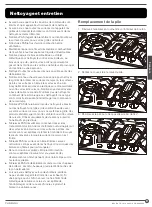
8
English
Manual Ignition:
WARNING
Use care when lighting the burners by hand. If a burner
lights unexpectedly, or your hand is to close to the burner,
you could be burned.
In the event of failure to ignite the burner in standard ignition,
you may light the burner manually by following the steps
below:
1. Turn the appropriate burner control knob
counterclockwise to the position.
2. Immediately strike and place a burning long wooden
match or a gas lighter near the burner to light.
3. Repeat steps 1 to 2 to light the other burner(s) as required.
4. Rotate the burner control knob to adjust the flame to
desired level.
If the Flame Goes Out
WARNING
Risk of Fire!
If the flame goes out accidentally, gas will escape. Never
leave the gas burner unattended during operation. Ensure
that there are no drafts that can affect the burner flame.
Immediately turn the control knob to the
OFF
position. Wait
at least 5 minutes and light the burner again.
Turning Off the Cooktop
WARNING
Always turn off the gas tank valve when refueling or
traveling.
To turn the cooktop burners off, rotate the control knobs
clockwise to the
OFF
position.
The Burner Flame
Flames should appear similar to the good flame shown in
diagram below.
Good
Blue
Blue
Bad
Yellow
Yellow
Holes in Burner
A good flame should be blue with a yellow tip.
Some yellow tips on flames up to 1" (25.4mm) in length are
acceptable as long as no carbon or soot deposits appear.
If flames are excessively yellow and irregular, the oil residue
may not be completely burned off, or the venturi may be
clogged or may not be properly positioned over the orifices.
Cleaning and Maintenance
●
Make sure all the control knobs are off and the appliance
is cool before cleaning.
●
Make sure all the appliance surfaces, burner grates and
burners are cool before cleaning or disassembling.
●
DO NOT use bleach or rust removers on the cooktop or
burner grates.
●
DO NOT obstruct the flow of combustion and ventilation
air.
●
Keep the appliance area clear of combustible materials,
gasoline and other flammable vapors and liquids.
●
Never use a wire brush or metallic item for cleaning burner
ports or orifices. Brush may “shed” bristles that may lodge
in the orifice or burner ports and cause a fire or explosion.
●
Clean all surfaces as soon as possible after boilovers or
spillovers.
●
Use warm soapy water only to clean the burner grates,
cooktops, painted surfaces, porcelain surfaces, stainless
steel surfaces and plastic items on your range or cooktop.
Do not use grit or acid-type cleaners. Do not use cleaners
with ammonia, Cleaners of these types are corrosive and
could damage component parts in the range.
●
DO NOT use steel wool, or abrasive cleaners, or acid type
cleaners such as chlorine bleach on your cooktop or grate
systems. They will damage your range or cooktop. Use
only non-abrasive plastic scrubbing pads.
●
DO NOT allow foods containing acids (such as lemons or
tomato juice, or vinegar) to remain on porcelain or painted
surfaces. Acids may remove the glossy finish. Wipe up
egg spills when cooktop is cool.
●
DO NOT wash warm porcelain surfaces. Allow these
areas to cool before cleaning. You could burn yourself or
the porcelain could crack.
●
Pitting and discoloration will result if spills are allowed to
remain for any length of time on stainless steel.
●
DO NOT allow spillovers to remain on the burner caps.
The caps could become permanently stained.
●
When cleaning around the burners, use care to prevent
damage to the electrode (if so equipped). If a sponge or
cloth should catch the metal igniter electrode, it could
damage or break the electrode. If this occurs the burner
will not light.
REV DATE: 10.14.2022 | CCD-0005583










































